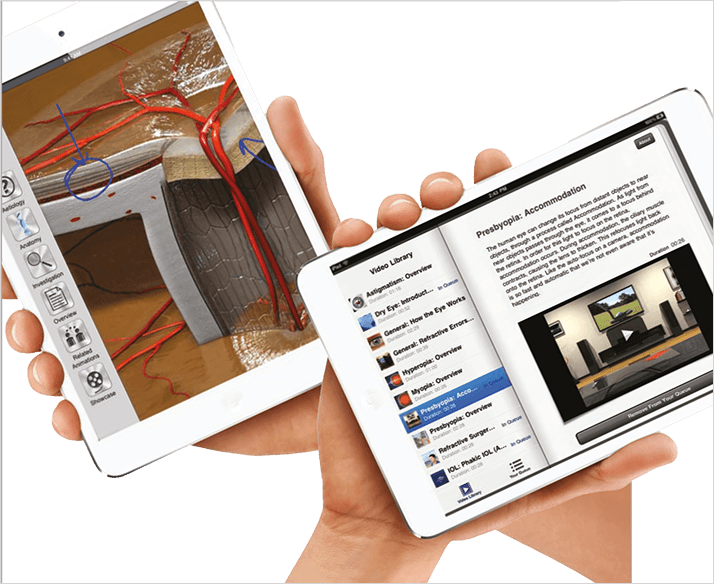
- Patient education helps manage expectations and improve outcomes
- 3D animations of ocular diseases and surgical procedures educate patients effectively
- Today’s electronic systems are interactive, brand-able and customizable
- Social media integration is built-in, giving performance metrics
Patient education is important for four reasons.
First, it improves outcomes. The patient who understands the procedure and what’s required of him or her before, during and after surgery will adhere more closely to the prescribed therapeutic protocols, improving their outcomes.Second, it reduces fear of the procedure. Ocular surgery, with its hooks, cannulae and phacoemulsification tips, can look terrifying, and it’s only a Google search away. This terror can be mitigated by educating the patient on what the technique is for, how it is performed, and by providing an honest appraisal of the risks and benefits of the procedure. This ties in to the third point: informed consent. Often, there are multiple elective treatment options for patients; they need to decide which one is the best for them from an informed position. Fourth, education manages expectations. Patients with unreasonable presumptions of what a procedure will give them are inevitably going to be disappointed by the post-operative optical reality. A patient with reasonable expectations of treatment success will most likely be pleased with the results – and may recommend your services to others via word-of-mouth, while a disgruntled patient will do the opposite.
Given the importance of the topic, you should pay great attention to how you educate your patients. If you are still using an old ophthalmology textbook to explain procedures, then it is time to move to a better way. Most of your patients will have higher expectations than to have you leaf through a medical book: smartphones and tablets have transformed how everyone accesses information, irrespective of their age. The good news is that computerized patient education suites provide an excellent way to inform patients. They walk through the causes and nature of ocular diseases and the surgical interventions that will treat them using three-dimensional animation. These videos convey all of the information graphically but in a manner that’s slightly detached from the actual, “wet” reality of eye surgery. In essence, the patient is fully educated, but without seeing any gore. One option is to sit the patient in front of a screen or hand them an iPad, and play the video. These systems can incorporate your branding and play a loop of videos in your waiting room, which not only looks good, but can also alert patients to some of the premium procedures on offer in your practice.
But systems like Optimed’s CAPTIV8 and EyeDraw or Eyemaginations’ 3D-Eye and LUMA applications (Figure 1) are not just repositories of 3D animations of ocular diseases and surgical interventions. You can do far more with them, interacting with the patient and the content while the video is playing. The content is split into multiple sections that represent a typical ophthalmologist’s workflow. You could choose only the sections that you feel require to be shown – so, for example, with cataract surgery, you may play the videos on the development of cataracts, what impact cataracts have on vision, the various surgical options (for example, using, or not using, a femtosecond laser system), how the intraocular lens (IOL) is placed, conclusion of the surgery, and post-surgical care notes. You can pause the video, and annotate or draw on the screen to facilitate discussion. And you can link to related content; a video that explains and illustrates points raised by your patients should be just a click or a tap away. What’s also useful is that you can email links to the patient. After you have watched videos with them, they can review them at their leisure, better facilitating their learning.

Patients can share these videos too. As they are branded with your practice’s logo and information, this means increased exposure for your practice on social media platforms like Facebook, Twitter and YouTube – at no further cost to you. The CAPTIV8 system actually monitors social media sharing, and can offer performance metrics of the extent and impact of patient’s social media sharing behavior, which is useful market insight that will inform how you market your practice. Eyemaginations’ ECHO offering can let practices send information – such as new patient forms, pre-operative instructions, and directions to the office – prior to the visit, saving staff time, or send content to patients post-visit, reinforcing both their diagnosis and the recommended treatment options, which patients can then share with family and friends via email or social media. If you haven’t already invested in an electronic, social-media connected patient education system, now may be the time to do so. The benefits of patient education are legion; the pitfalls of not doing so are many and well-documented. The fact that such systems can help market your practice and tell you how well it has done so is a useful side-benefit.
